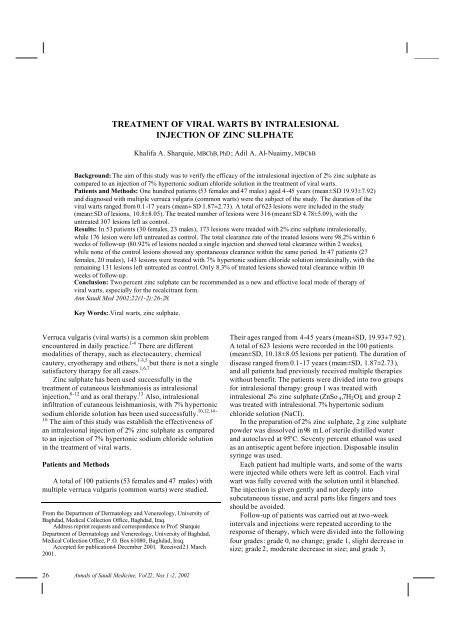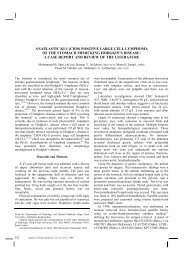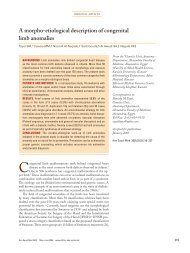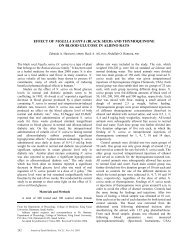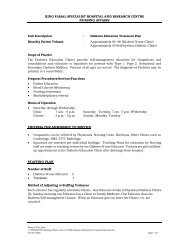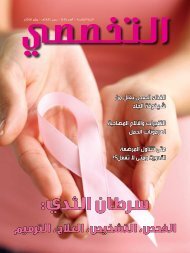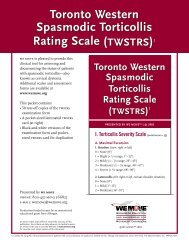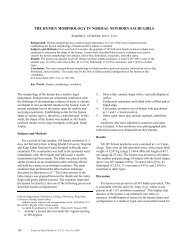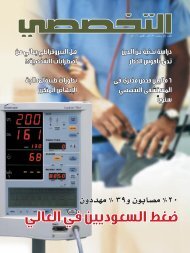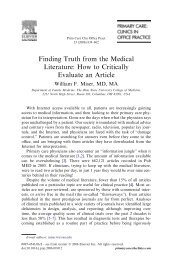treatment of viral warts by intralesional injection of zinc sulphate
treatment of viral warts by intralesional injection of zinc sulphate
treatment of viral warts by intralesional injection of zinc sulphate
Create successful ePaper yourself
Turn your PDF publications into a flip-book with our unique Google optimized e-Paper software.
TREATMENT OF VIRAL WARTS BY INTRALESIONAL<br />
INJECTION OF ZINC SULPHATE<br />
26 Annals <strong>of</strong> Saudi Medicine, Vol 22 , Nos 1 -2, 2002<br />
Khalifa A. Sharquie, MBChB, PhD; Adil A. Al-Nuaimy, MBChB<br />
Background: The aim <strong>of</strong> this study was to verify the efficacy <strong>of</strong> the <strong>intralesional</strong> <strong>injection</strong> <strong>of</strong> 2% <strong>zinc</strong> <strong>sulphate</strong> as<br />
compared to an <strong>injection</strong> <strong>of</strong> 7% hypertonic sodium chloride solution in the <strong>treatment</strong> <strong>of</strong> <strong>viral</strong> <strong>warts</strong>.<br />
Patients and Methods: One hundred patients (53 females and 47 males) aged 4-45 years (mean±SD 19.93±7.92)<br />
and diagnosed with multiple verruca vulgaris (common <strong>warts</strong>) were the subject <strong>of</strong> the study. The duration <strong>of</strong> the<br />
<strong>viral</strong> <strong>warts</strong> ranged from 0.1-17 years (mean± SD 1.87±2.73). A total <strong>of</strong> 623 lesions were included in the study<br />
(mean±SD <strong>of</strong> lesions, 10.8±8.05). The treated number <strong>of</strong> lesions were 316 (mean±SD 4.78±5.09), with the<br />
untreated 307 lesions left as control.<br />
Results: In 53 patients (30 females, 23 males), 173 lesions were treaded with 2% <strong>zinc</strong> <strong>sulphate</strong> <strong>intralesional</strong>ly,<br />
while 176 lesion were left untreated as control. The total clearance rate <strong>of</strong> the treated lesions were 98.2% within 6<br />
weeks <strong>of</strong> follow-up (80.92% <strong>of</strong> lesions needed a single <strong>injection</strong> and showed total clearance within 2 weeks),<br />
while none <strong>of</strong> the control lesions showed any spontaneous clearance within the same period. In 47 patients (27<br />
females, 20 males), 143 lesions were treated with 7% hypertonic sodium chloride solution intralesinally, with the<br />
remaining 131 lesions left untreated as control. Only 8.3% <strong>of</strong> treated lesions showed total clearance within 10<br />
weeks <strong>of</strong> follow-up.<br />
Conclusion: Two percent <strong>zinc</strong> <strong>sulphate</strong> can be recommended as a new and effective local mode <strong>of</strong> therapy <strong>of</strong><br />
<strong>viral</strong> <strong>warts</strong>, especially for the recalcitrant form.<br />
Ann Saudi Med 2002;22(1-2):26-28.<br />
Key Words:.Viral <strong>warts</strong>, <strong>zinc</strong> <strong>sulphate</strong>.<br />
Verruca vulgaris (<strong>viral</strong> <strong>warts</strong>) is a common skin problem<br />
encountered in daily practice. 1-4 There are different<br />
modalities <strong>of</strong> therapy, such as electocautery, chemical<br />
cautery, cryotherapy and others, 1-3,5 but there is not a single<br />
satisfactory therapy for all cases. 1,6,7<br />
Zinc <strong>sulphate</strong> has been used successfully in the<br />
<strong>treatment</strong> <strong>of</strong> cutaneous leishmaniosis as <strong>intralesional</strong><br />
<strong>injection</strong>, 8-12 and as oral therapy. 13 Also, <strong>intralesional</strong><br />
infiltration <strong>of</strong> cutaneous leishmaniosis, with 7% hypertonic<br />
sodium chloride solution has been used successfully. 10,12,14-<br />
16 The aim <strong>of</strong> this study was establish the effectiveness <strong>of</strong><br />
an <strong>intralesional</strong> <strong>injection</strong> <strong>of</strong> 2% <strong>zinc</strong> <strong>sulphate</strong> as compared<br />
to an <strong>injection</strong> <strong>of</strong> 7% hypertonic sodium chloride solution<br />
in the <strong>treatment</strong> <strong>of</strong> <strong>viral</strong> <strong>warts</strong>.<br />
Patients and Methods<br />
A total <strong>of</strong> 100 patients (53 females and 47 males) with<br />
multiple verruca vulgaris (common <strong>warts</strong>) were studied.<br />
From the Department <strong>of</strong> Dermatology and Venereology, University <strong>of</strong><br />
Baghdad, Medical Collection Office, Baghdad, Iraq.<br />
Address reprint requests and correspondence to Pr<strong>of</strong>. Sharquie<br />
Department <strong>of</strong> Dermatology and Venereology, University <strong>of</strong> Baghdad,<br />
Medical Collection Office, P .O. Box 61080, Baghdad, Iraq.<br />
Accepted for publication 4 December 2001. Received 21 March<br />
2001.<br />
Their ages ranged from 4-45 years (mean±SD, 19.93±7.92).<br />
A total <strong>of</strong> 623 lesions were recorded in the 100 patients<br />
(mean±SD, 10.18±8.05 lesions per patient). The duration <strong>of</strong><br />
disease ranged from 0.1-17 years (mean±SD, 1.87±2.73),<br />
and all patients had previously received multiple therapies<br />
without benefit. The patients were divided into two groups<br />
for <strong>intralesional</strong> therapy: group 1 was treated with<br />
<strong>intralesional</strong> 2% <strong>zinc</strong> <strong>sulphate</strong> (ZnSo 4,7H2O); and group 2<br />
was treated with <strong>intralesional</strong> 7% hypertonic sodium<br />
chloride solution (NaCI).<br />
In the preparation <strong>of</strong> 2% <strong>zinc</strong> <strong>sulphate</strong>, 2 g <strong>zinc</strong> <strong>sulphate</strong><br />
powder was dissolved in 98 mL <strong>of</strong> sterile distilled water<br />
and autoclaved at 95ºC. Seventy percent ethanol was used<br />
as an antiseptic agent before <strong>injection</strong>. Disposable insulin<br />
syringe was used.<br />
Each patient had multiple <strong>warts</strong>, and some <strong>of</strong> the <strong>warts</strong><br />
were injected while others were left as control. Each <strong>viral</strong><br />
wart was fully covered with the solution until it blanched.<br />
The <strong>injection</strong> is given gently and not deeply into<br />
subcutaneous tissue, and acral parts like fingers and toes<br />
should be avoided.<br />
Follow-up <strong>of</strong> patients was carried out at two-week<br />
intervals and <strong>injection</strong>s were repeated according to the<br />
response <strong>of</strong> therapy, which were divided into the following<br />
four grades: grade 0, no change; grade 1, slight decrease in<br />
size; grade 2, moderate decrease in size; and grade 3,
complete clearance <strong>of</strong> lesion (grade 3 was considered a<br />
cure).<br />
Results<br />
Of the 623 lesions recorded in the 100 patients, 316<br />
lesions were treated with both 2% <strong>zinc</strong> <strong>sulphate</strong> and 7%<br />
hypertonic sodium chloride solution, while the remaining<br />
307 lesions were left untreated as control.<br />
Result <strong>of</strong> Treated Lesions with 2% Zinc Sulphate<br />
There were 349 lesions on 53 patients, and <strong>of</strong> these, 173<br />
lesions were treated and 176 were left untreated as control.<br />
The 173 lesions were treated with single <strong>injection</strong> <strong>of</strong> 2%<br />
<strong>zinc</strong> <strong>sulphate</strong>, and after a two-week follow up, 140 lesions<br />
(80.92%) had totally cleared and were considered cured.<br />
Those lesions that failed with the first <strong>injection</strong> (33 lesions)<br />
received a second <strong>injection</strong> at the end <strong>of</strong> the second week.<br />
After follow-up after another two weeks, 28 lesions<br />
(84.84%) had totally cleared. A third <strong>injection</strong> was needed<br />
for the remaining five lesions, two <strong>of</strong> which were cured, but<br />
the rest failed at the end <strong>of</strong> six weeks. Thus, the total<br />
clearance rate for all treated lesions was 170 (98.2%), while<br />
the failure rate was three lesions (1.73% ). In the follow-up,<br />
no new lesion had appeared at the site <strong>of</strong> the cured lesions<br />
(Table 1). The 176 lesions which were left untreated as<br />
control showed no spontaneous clearance at the end <strong>of</strong> a 6week<br />
follow up.<br />
Side Effects<br />
All patients complained <strong>of</strong> pain during <strong>injection</strong>, and<br />
2% xylocaine was added to the solution when necessary.<br />
All treated lesions showed redness, tenderness, swelling<br />
and development <strong>of</strong> a scab 3-7 days after <strong>injection</strong>. All<br />
patients had post-inflammatory hyperpigmentation after<br />
total clearance <strong>of</strong> lesions. Only two patients had cigarette<br />
paper-like scar, probably because their lesions were large<br />
and needed more infiltration.<br />
Result <strong>of</strong> Treated Lesions with Hypertonic Sodium Chloride<br />
Solution<br />
Of the 274 lesions from 47 patients, 143 were treated<br />
and 131 lesions were left untreated as control. The 143<br />
lesions were each treated with a single <strong>injection</strong> <strong>of</strong> 7%<br />
hypertonic sodium chloride solution. After a t wo-week<br />
follow-up, only seven lesions (4.89%) had totally cleared.<br />
A total <strong>of</strong> 136 lesions failed with the first <strong>injection</strong>, and<br />
were given a second <strong>injection</strong> at the end <strong>of</strong> the second<br />
week. Follow-up after another two weeks showed that four<br />
lesions had totally cleared.<br />
The remaining 122 lesions received a third <strong>injection</strong> at<br />
the end <strong>of</strong> the fourth week, and none showed improvement.<br />
Fifty-six lesions received a fourth <strong>injection</strong> at the end <strong>of</strong> six<br />
week, and only one lesion (1.7% ) showed complete<br />
clearance. Twenty-seven lesions received a fifth <strong>injection</strong> at<br />
the end <strong>of</strong> eight week and none showed any response. Thus,<br />
TREATMENT OF VIRAL WARTS<br />
TABLE 1. The number <strong>of</strong> lesions treated with 2% <strong>zinc</strong> <strong>sulphate</strong>.<br />
No. <strong>of</strong><br />
<strong>injection</strong><br />
Cumulative period<br />
<strong>of</strong> follow-up<br />
Treated<br />
lesions<br />
Cured*<br />
Lesions<br />
Non -cured<br />
lesions<br />
1 2 weeks 173 140 80.92% 33 19.07<br />
%<br />
2 4 weeks 33 28 84.84% 5 15.15<br />
%<br />
3 6 weeks 5 2 40% 3 60%<br />
*Cure rate 98.2%; failure rate 1.73%.<br />
TABLE 2. The number <strong>of</strong> lesions treated with 7% hypertonic sodium<br />
chloride solution.<br />
No. <strong>of</strong> Cumulative period Treated Cured* Non -cured<br />
<strong>injection</strong> <strong>of</strong> follow-up lesions Lesions lesions<br />
1 2 weeks 143 7 4.84% 136 95.1%<br />
2 4 weeks 136 4 2.94% 132 97.05%<br />
3 6 weeks 122 – – 122 100%<br />
4 8 weeks 56 1 1.7% 55 98.2%<br />
5 10 weeks 27 – – 27 100%<br />
*Cure rate 8.39%; failure rate 91.6%.<br />
the total clearance rate for all the treated lesions was 8.39%<br />
(12 lesions), while the failure rate was 91.6% (131 lesions).<br />
In the follow-up, the appearance <strong>of</strong> new lesions on the<br />
cured site <strong>of</strong> three lesions was observed. Regarding the 131<br />
lesions which were left untreated as control, none showed<br />
clearance at the end <strong>of</strong> this study except one lesion.<br />
Side Effects<br />
The <strong>injection</strong> with 7% hypertonic sodium chloride<br />
solution was less painful than that <strong>of</strong> the 2% <strong>zinc</strong> <strong>sulphate</strong><br />
solution. The <strong>injection</strong> with sodium chloride solution<br />
produced post-inflammation and hyperpigmentation similar<br />
to that <strong>of</strong> the <strong>zinc</strong> <strong>sulphate</strong>, but did not leave scars.<br />
Discussion<br />
Although spontaneous recovery from verruca vulagaris<br />
is high, it usually takes a long time , sometime lasting for<br />
years. 1-3,5,17 There are many modalities <strong>of</strong> therapy, but most<br />
<strong>of</strong> them take months, and might also cause scarring. 1-5,17<br />
Whatever method is used, there are failures as well as<br />
recurrence <strong>of</strong> the lesion. 3 Common <strong>warts</strong> are common<br />
benign lesions for which no specific anti<strong>viral</strong> <strong>treatment</strong> is<br />
available. 1,6,7<br />
The outcome <strong>of</strong> the present study with 2% <strong>zinc</strong> <strong>sulphate</strong><br />
was very encouraging, as the cure rate was 98.2% and most<br />
<strong>of</strong> them (80.92% ) needed just a single <strong>injection</strong>. The side<br />
effects <strong>of</strong> this <strong>treatment</strong> were just local pain, swelling and<br />
hyperpigmentation. The solution should not be injected<br />
deep in the subcutaneous tissue, and the acral parts such as<br />
fingers and toes should be avoided as they might cause<br />
necrosis, which is similar to the side effects <strong>of</strong> local<br />
<strong>injection</strong> <strong>of</strong> bleomycin. 3,5,18-22 In our study, no patient had<br />
relapse at site <strong>of</strong> the cured lesions.<br />
The mechanism <strong>of</strong> action <strong>of</strong> <strong>zinc</strong> <strong>sulphate</strong> in <strong>viral</strong> <strong>warts</strong><br />
cannot be speculated but is probably similar to the action <strong>of</strong><br />
<strong>zinc</strong> <strong>sulphate</strong> in cutaneous leishmanesis 8-10,12 and bleomycin<br />
Annals <strong>of</strong> Saudi Medicine, Vol 22, Nos 1 -2, 2002 27
SHARQUIE AND AL-NUAIMY<br />
on <strong>viral</strong> <strong>warts</strong>, as both induce necrosis and<br />
inflammation. 1,18,23,24<br />
The mechanism <strong>of</strong> action <strong>of</strong> 7% hypertonic sodium<br />
chloride solution in cutaneous leishmanesis was through its<br />
hypertonic effect <strong>of</strong> inducing change in osmosis, thus<br />
killing the parasite and lesions, 10,12,14 -16 while 2% <strong>zinc</strong><br />
<strong>sulphate</strong> probably has a direct effect on the parasite, and<br />
inducing necrosis and inflammation in the lesional tissue<br />
rather than through osmosis. 8-10,12,13 The hypertonic sodium<br />
chloride solution showed a very low cure rate (8.2%), since<br />
the viruses shield themselves inside keratinocytes which are<br />
more resistant to the osmotic changes.<br />
In conclusion, this study provides details <strong>of</strong> a new<br />
effective local therapy for <strong>viral</strong> <strong>warts</strong> with a high cure rate<br />
(98.2%). A recent study has been carried out using oral <strong>zinc</strong><br />
<strong>sulphate</strong> in treating recalcitrant <strong>viral</strong> <strong>warts</strong> and which gave<br />
a high cure rate. 25<br />
References<br />
1. Lowry DR, Androphy EJ. Warts in dermatology in general medicine.<br />
5th edition . In: Fitzpatrick TB, Eisen AZ, Wolffk Freedberg IM,<br />
Austen KF, Goldsmith LA, Katz SI, editors. New York: McGraw<br />
Hill Book Co., 1999;244:2484 -97.<br />
2. Odom RB, James WD, Berger TG. Viral diseases. In: Andrew’s<br />
Diseases <strong>of</strong> the Skin: Clinical Dermatology. 9th edition.<br />
Philadelphia: WB Saunders Company, 2000:473-525.<br />
3. Sterling JC, Kurtz JB. Viral infections. In: Champion RH, Burton JL,<br />
Burns DA, Breathmach SM, editors. Textbook <strong>of</strong> Dermatology. 6th<br />
edition, Vol 2. Oxford: Blackwell Science Ltd, 1998;26:995-1097.<br />
4. Sharquie KE, Mohammed BJ. A survey <strong>of</strong> cutaneous <strong>viral</strong> <strong>warts</strong> in<br />
Iraqi patients. Diploma thesis. College <strong>of</strong> Medicine, University <strong>of</strong><br />
Baghdad, Iraq, 1989:24-5.<br />
5. Habif TP. Warts, herpes simplex and other <strong>viral</strong> infections in clinical<br />
dermatology. A color guide to diagnosis and therapy: New York:<br />
Mos<strong>by</strong>-Year Book Inc., 1996;12:325-61.<br />
6. Lambert J, Richbert B, De-la-Brassinne M. Pharmaclinics. How I<br />
treat periungual <strong>warts</strong>. Rev Med (Liege) 1999;54:646 -52.<br />
7. El Tonsy MH, Anbar TE, El-Domyate M, Barakat M. Density <strong>of</strong><br />
<strong>viral</strong> particles in pre- and post-Nd:YAD laser hyperthermia therapy<br />
and cryotherapy in plantar <strong>warts</strong>. Int J Dermatol 1999;38:393-8.<br />
8. Sharquie KE, Al-Azzawi KE. Intralesional therapy <strong>of</strong> cutaneous<br />
leishmaniasis with 2% <strong>zinc</strong> <strong>sulphate</strong> solution. Iraqi Central<br />
Organization for Specification and Quality Control/Patent Section.<br />
Baghdad, Iraq, 1996.<br />
9. Sharquie KE, Al-Azzawi KE. Intralesional therapy <strong>of</strong> cutaneous<br />
leishmaniasis with 2% <strong>zinc</strong> <strong>sulphate</strong> solution. J Pan-Arab League<br />
Dermatologists, 1996;7:41-6.<br />
28 Annals <strong>of</strong> Saudi Medicine, Vol 22 , Nos 1 -2, 2002<br />
10. Al-Jubouri OM. Quantitative therapeutic reassessment <strong>of</strong> hypertonic<br />
sodium chloride solution and <strong>zinc</strong> <strong>sulphate</strong> injected <strong>intralesional</strong>ly in<br />
cutaneous leishmaniasis. Diploma Dissertation. College <strong>of</strong> Medicine,<br />
University <strong>of</strong> Baghdad, Iraq, 1995.<br />
11. Najim RA, Sharquie KE, Farjou IB. Zinc <strong>sulphate</strong> in the <strong>treatment</strong> <strong>of</strong><br />
cutaneous leishmaniasis: an in vitro and animal study. Nem Inst<br />
Oswoldo Cruz 1998;93:831-7.<br />
12. Sharquie KE, Najim RA, Farjou IB. A comparative controlled trial <strong>of</strong><br />
<strong>intralesional</strong>ly administered <strong>zinc</strong> <strong>sulphate</strong>, hypertonic sodium<br />
chloride and pentavalent antimony compound against acute<br />
cutaneous leishmaniasis. Clin Exp Dermatol 1997;22:169-73.<br />
13. Sharquie KE, Najim RA, Farjou IB, Al Timmi D. Oral <strong>zinc</strong> <strong>sulphate</strong><br />
in <strong>treatment</strong> <strong>of</strong> cutaneous leishmaniasis. Clin Exp Dermatol (in<br />
press), 2001.<br />
14. Sharquie KE. A new <strong>intralesional</strong> therapy <strong>of</strong> cutaneous leishmaniasis<br />
with hypertonic sodium chloride solution. Iraqi Central Organization<br />
for Specification and Quality Control/Patent Section. Baghdad, Iraq,<br />
1993.<br />
15. Sharquie KE. A new <strong>intralesional</strong> therapy for cutaneous<br />
leishmaniasis with hypertonic sodium chloride solution. J Dermatol<br />
(Japan) 1995;22:732 -7.<br />
16. Sharquie KE, Hussien AK, Turki KM. Intralesional therapy <strong>of</strong><br />
cutaneous leishmaniasis with hypertonic sodium chloride solution. J<br />
Pan-Arab League Dermatologists, 1994;5:85 -91.<br />
17. Hunter JAA, Savin JA, Dahl MV. Clinical Dermatology, 2nd edition.<br />
Oxford: Osney Mead, 1996;15:161-95.<br />
18. Sobh MA, Abd El-Razic MM, Rizc RA, Eid MM, Abd El-Hamid LA<br />
Ghoneim MA. Intralesional <strong>injection</strong> <strong>of</strong> bleomycin <strong>sulphate</strong> into<br />
resistant <strong>warts</strong> in renal transplant recipients versus non-transplant<br />
warty patients. Acta Derm Venereol 1991;71:63-66.<br />
19. Manz LA, Pelaychyk JM. Bleomycin licodaine mixture reduces pain<br />
<strong>of</strong> <strong>intralesional</strong> <strong>injection</strong>s in the <strong>treatment</strong> <strong>of</strong> recalcitrant verrucae. J<br />
Am Acad Dermatol 1991;25:524-6.<br />
20. Gonzales FU, Gil MCG, Martinez AA. Cutaneous toxicity <strong>of</strong><br />
<strong>intralesional</strong> bleomycin in the <strong>treatment</strong> <strong>of</strong> periungual <strong>warts</strong>. Arch<br />
Dermatol 1986;122:974 -5.<br />
21. Miller RAW. Nail dystrophy following <strong>intralesional</strong> <strong>injection</strong>s <strong>of</strong><br />
bleomycin for periungual <strong>warts</strong>. Arch Dermatol 1984;120:963-4.<br />
22. Amer M, Diab N, Ramadan A, Galal A, Salem A. Therapeutic<br />
evaluation for <strong>intralesional</strong> <strong>injection</strong> <strong>of</strong> bleomycin sulfate in 143<br />
resistant <strong>warts</strong>. J Am Acad Dermatol 1998;18:1313-6.<br />
23. Templeton SF, Solomon AR, Swerlick RA. Intradermal bleomycin<br />
<strong>injection</strong>s into normal human skin. A histopathologic and immunopathologic<br />
study. Arch Dermatol 1994;130:577 -83.<br />
24. James MP, Collier PM, Aherne W, Hardcastle A, Lovegrove S.<br />
Histologic, pharmacologic and immunocytochemical effects <strong>of</strong><br />
<strong>injection</strong>s <strong>of</strong> bleomycin into <strong>viral</strong> <strong>warts</strong>. J Am Acad Dermatol 1993;<br />
28:993-7.<br />
25. Al Gurairi FT, Al-Waiz M. Oral <strong>zinc</strong> <strong>sulphate</strong> in the <strong>treatment</strong> <strong>of</strong><br />
recalcitrant <strong>viral</strong> <strong>warts</strong>. Fellowship <strong>of</strong> Iraqi Commission for Medical<br />
Specialization in Dermatology and Venereology Dissertation.<br />
Scientific Committee <strong>of</strong> Dermatology and Venereology, 2001.


